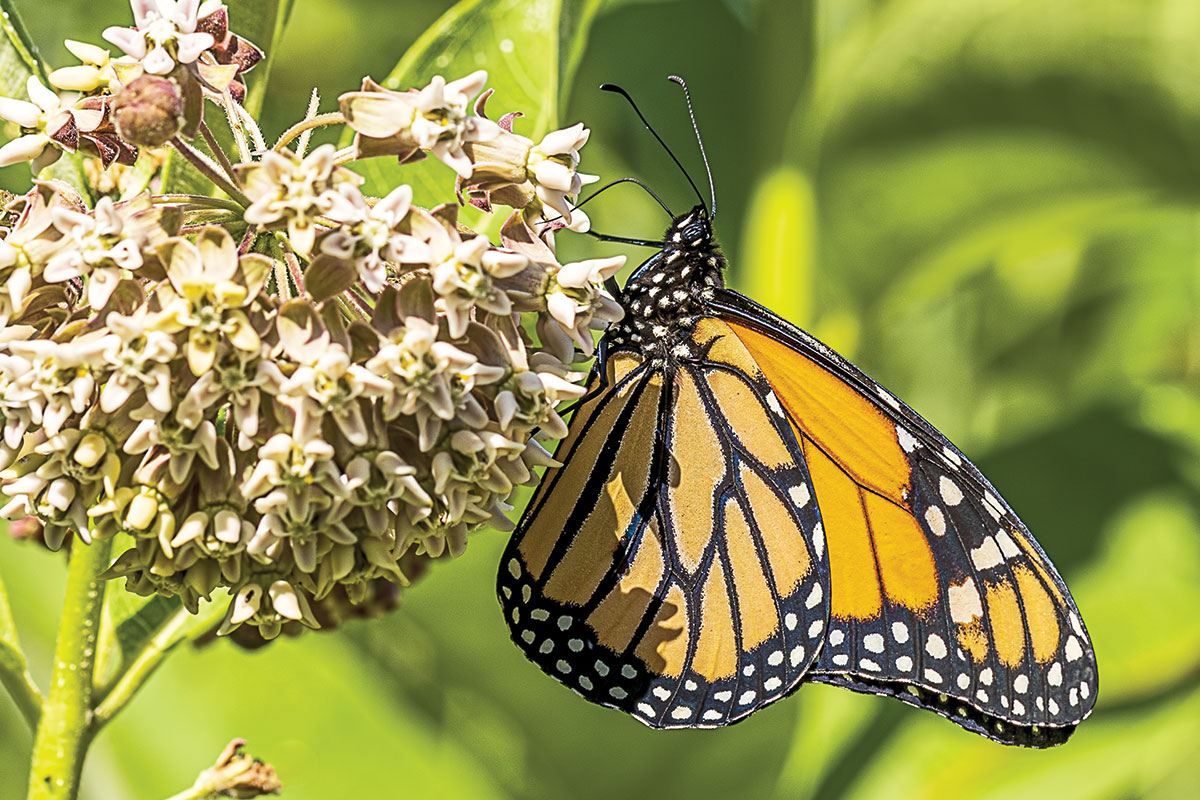Last summer I saw an orange and black butterfly in my garden—only one. I took it to be the endangered monarch butterfly, the first I had seen in years. I had allowed the native milkweed to grow in the garden instead of pulling it out. Maybe that butterfly was looking for milkweed plants as a place to hatch its eggs.
A reference book showed me the monarch butterfly (Danaus plexippus) has two pairs of brilliant orange-red wings, with black veins and white spots along the edges. Males are slightly bigger than females and have distinguishing black dots along the veins of their wings.
Besides bringing beauty to our lives, monarch butterflies contribute to the health of our planet. While feeding on nectar, they pollinate and promote the growth of many types of plants, including those we find necessary for our own sustenance.
Monarchs overwinter in mainly three areas: Florida, Mexico, and Coastal California. They seek out specific microclimate conditions, including dappled sunlight, high humidity, access to fresh water, and an absence of freezing temperature or high wind. Those that are most endangered overwinter in the coastal areas of California. These butterflies use the Western United States and Southern Canada for their summer migration routes.
Population counts in the overwintering grounds of California’s coastal forested groves and the oyamel fir forest north of Mexico City, Mexico, determined the population of monarch butterflies has diminished since 1980 from at least 4.5 million down to around 2,000. The winter of 2021-2022 did see an increased count to approximately 250,000, which is encouraging. However, a one-year increase does not determine the species is no longer endangered. Experts find the average of the counts over several years is more telling.
Interrelated factors for the decline include habitat loss in breeding and overwintering sites, habitat degradations, disease, and pesticide exposure. The latest additional factor for decline is climate change that provokes drought, severe storms, and wild fires, all conditions contributing to the butterfly’s demise.
As well, earlier springs and warmer temperatures can disrupt the time of the monarch’s migration and breeding patterns. Due to fears of the monarch butterfly becoming extinct, this species will be federally listed as endangered in 2024.
The monarch butterfly that migrates to Montana and Idaho overwinters in two western regions. A Montana Field Guide indicates those found on the west side of the continental divide likely overwinter in Southern California while those found on the eastern side overwinter in Mexico.
The monarch migrates north each summer in steps. It starts its life cycle where it overwinters by laying eggs that develop into larvae (caterpillar), next the pupa (chrysalis), and finally the adult butterfly. The newly developed butterfly, which lives only four to five weeks, migrates north and starts the life cycle again by laying its eggs in a new location.
Once the egg hatches and goes through the cycle, the new butterfly continues the migration north until it, too, is ready to find milkweed to hatch its eggs. These steps repeat themselves until four generations of butterflies emerge in one season. The last generation finds its way back to the original wintering grounds.
Much can happen to snuff out the butterfly during the migration stages. Covering land with housing and asphalt reduces habitat where native milkweed could grow. Milkweed is essential when the butterfly lays its eggs because milkweed is the major source of food for caterpillars as they become fully grown butterflies.
To attract and support the monarch, the California Department of Fish and Wildlife has been focusing on encouraging the availability of early-season native milkweed on lands owned by Fish and Wildlife.
Since natural habitat has exponentially diminished in recent years, dependence on gardeners growing varieties of milkweed and other butterfly-friendly plants is likely to become necessary.
Seed catalogs now offer gardeners a variety of interesting milkweeds that flower in assorted colors. Growers, however, should be cautious and ask questions.
The Xerces Society, a science-based nonprofit organization that protects wildlife through the conservation of invertebrates and their habitats, recently did a study and found the plants many nurseries sold had pesticides on the leaves.
Individuals can take measures to promote the growth of native milkweed. The plants typically flourish in moderately acidic soil having PH levels between 4.8 and 6.8. Give sprouts space to grow, and plant them in patches of at least six plants with multiple patches scattered around the yard.
Fence the patches off to protect them from foot traffic until they become well established.
You can check out the national directory of milkweed vendors at xerces.org/milkweed/milkweed-seed-finder and plant a variety of milkweed to enjoy while also providing an essential plant for the monarch butterfly. MSN










